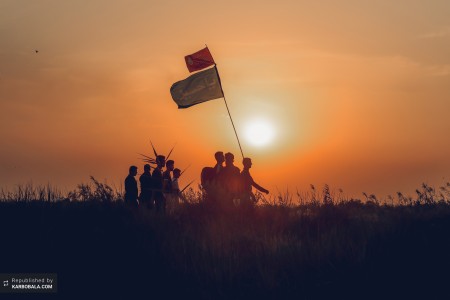The Importance of Arbaeen Walk
In 680 AD, Imam Husayn (AS) and his companions were massacred by the Umayyad army at Karbala on tenth of Muharram, a day known as ‘Ashura’, commemorated every year by Shia Muslims. Forty days after Ashura, Shia Muslims also mark the day every year when they perform the pilgrimage on foot, called Arbaeen walk, starting from the shrine of Imam Ali (AS) in Najaf to Karbala in Iraq where Imam Husayn (AS), the grandson of Prophet Muhammad (PBUH), is buried, covering more than 85 kilometers.
The annual Arbaeen walk to the holy city of Karbala, includes men, women, and children of all ages and nationalities. Thousands of tents known as ‘Mawakibs’ mark the path, offering everything from food and water to phone stations and resting places. The pilgrims wear veils, turbans, and modest clothing – abayas, niqabs, and caftans – offering protection from the desert heat. It is important that they approach their destination in a pious state. Once they reach their destination, the pilgrims say prayers, read the Qur’an, weep, and ask for forgiveness of their sins.
Recommended, Affordable and Unrestricted
This annual Arbaeen pilgrimage to Karbala in Iraq, where over twenty million pilgrims travel to the Imam Husayn’s (AS) shrine in Iraq, being the largest pilgrimage in the world, is a major life event and is strongly encouraged by religious clerics. One popular Shia tradition mentions, “A single tear shed for Husayn washes away a hundred sins.”[1]
For some, the journey to Karbala is secondary to hajj, but for others it is an alternative to the pilgrimage to Mecca due to latter’s limited seats and former’s affordability, the reason why it outnumbers Hajj every year. While Shias contribute to the majority of the pilgrims, it is not exclusive to them as many non-Shias and non-Muslims band together in this pilgrimage.
Unity and Brotherhood
The Arbaeen pilgrimage is a symbol of unity among the followers of different faiths too. Over the years, various religious groups of Christians, Zoroastrians and Sabbatians as well as delegations from Vatican City and Iraq have taken part in this holy walk. One can see non-Shias participating in the walk along with distributing free edibles on the way. Some even set up their own Mawakibs manifesting their difference of their faith but unity under the banner of Imam Husayn (AS). Overall, the atmosphere of the walk itself is harmonious depicting the walk’s importance.
References
Pilgrimage in Islam by Sophia Rose Arjana
The Shia Revival: How Conflicts within Islam Will Shape the Future by Vali Nasr
http://en.alalam.ir/news/1547521
https://www.huffingtonpost.co.uk/sayed-mahdi-almodarresi/arbaeen-pilgrimage_b_6203756.html
https://english.alaraby.co.uk/news/millions-pilgrims-trek-iraqs-karbala-arbaeen
https://nation.com.pk/05-Nov-2017/arbaeen-a-spiritual-walk
[1] Nasr, Vali. The Shia Revival: How Conflicts within Islam Will Shape the Future, New York: W.W. Norton & Company, 2006, p. 50
